
- •Preface
- •Foreword
- •Contents
- •Contributors
- •1. Medical History
- •1.1 Congestive Heart Failure
- •1.2 Angina Pectoris
- •1.3 Myocardial Infarction
- •1.4 Rheumatic Heart Disease
- •1.5 Heart Murmur
- •1.6 Congenital Heart Disease
- •1.7 Cardiac Arrhythmia
- •1.8 Prosthetic Heart Valve
- •1.9 Surgically Corrected Heart Disease
- •1.10 Heart Pacemaker
- •1.11 Hypertension
- •1.12 Orthostatic Hypotension
- •1.13 Cerebrovascular Accident
- •1.14 Anemia and Other Blood Diseases
- •1.15 Leukemia
- •1.16 Hemorrhagic Diatheses
- •1.17 Patients Receiving Anticoagulants
- •1.18 Hyperthyroidism
- •1.19 Diabetes Mellitus
- •1.20 Renal Disease
- •1.21 Patients Receiving Corticosteroids
- •1.22 Cushing’s Syndrome
- •1.23 Asthma
- •1.24 Tuberculosis
- •1.25 Infectious Diseases (Hepatitis B, C, and AIDS)
- •1.26 Epilepsy
- •1.27 Diseases of the Skeletal System
- •1.28 Radiotherapy Patients
- •1.29 Allergy
- •1.30 Fainting
- •1.31 Pregnancy
- •Bibliography
- •2.1 Radiographic Assessment
- •2.2 Magnification Technique
- •2.4 Tube Shift Principle
- •2.5 Vertical Transversal Tomography of the Jaw
- •Bibliography
- •3. Principles of Surgery
- •3.1 Sterilization of Instruments
- •3.2 Preparation of Patient
- •3.3 Preparation of Surgeon
- •3.4 Surgical Incisions and Flaps
- •3.5 Types of Flaps
- •3.6 Reflection of the Mucoperiosteum
- •3.7 Suturing
- •Bibliography
- •4.1 Surgical Unit and Handpiece
- •4.2 Bone Burs
- •4.3 Scalpel (Handle and Blade)
- •4.4 Periosteal Elevator
- •4.5 Hemostats
- •4.6 Surgical – Anatomic Forceps
- •4.7 Rongeur Forceps
- •4.8 Bone File
- •4.9 Chisel and Mallet
- •4.10 Needle Holders
- •4.11 Scissors
- •4.12 Towel Clamps
- •4.13 Retractors
- •4.14 Bite Blocks and Mouth Props
- •4.15 Surgical Suction
- •4.16 Irrigation Instruments
- •4.17 Electrosurgical Unit
- •4.18 Binocular Loupes with Light Source
- •4.19 Extraction Forceps
- •4.20 Elevators
- •4.21 Other Types of Elevators
- •4.22 Special Instrument for Removal of Roots
- •4.23 Periapical Curettes
- •4.24 Desmotomes
- •4.25 Sets of Necessary Instruments
- •4.26 Sutures
- •4.27 Needles
- •4.28 Local Hemostatic Drugs
- •4.30 Materials for Tissue Regeneration
- •Bibliography
- •5. Simple Tooth Extraction
- •5.1 Patient Position
- •5.2 Separation of Tooth from Soft Tissues
- •5.3 Extraction Technique Using Tooth Forceps
- •5.4 Extraction Technique Using Root Tip Forceps
- •5.5 Extraction Technique Using Elevator
- •5.6 Postextraction Care of Tooth Socket
- •5.7 Postoperative Instructions
- •Bibliography
- •6. Surgical Tooth Extraction
- •6.1 Indications
- •6.2 Contraindications
- •6.3 Steps of Surgical Extraction
- •6.4 Surgical Extraction of Teeth with Intact Crown
- •6.5 Surgical Extraction of Roots
- •6.6 Surgical Extraction of Root Tips
- •Bibliography
- •7.1 Medical History
- •7.2 Clinical Examination
- •7.3 Radiographic Examination
- •7.4 Indications for Extraction
- •7.5 Appropriate Timing for Removal of Impacted Teeth
- •7.6 Steps of Surgical Procedure
- •7.7 Extraction of Impacted Mandibular Teeth
- •7.8 Extraction of Impacted Maxillary Teeth
- •7.9 Exposure of Impacted Teeth for Orthodontic Treatment
- •Bibliography
- •8.1 Perioperative Complications
- •8.2 Postoperative Complications
- •Bibliography
- •9. Odontogenic Infections
- •9.1 Infections of the Orofacial Region
- •Bibliography
- •10. Preprosthetic Surgery
- •10.1 Hard Tissue Lesions or Abnormalities
- •10.2 Soft Tissue Lesions or Abnormalities
- •Bibliography
- •11.1 Principles for Successful Outcome of Biopsy
- •11.2 Instruments and Materials
- •11.3 Excisional Biopsy
- •11.4 Incisional Biopsy
- •11.5 Aspiration Biopsy
- •11.6 Specimen Care
- •11.7 Exfoliative Cytology
- •11.8 Tolouidine Blue Staining
- •Bibliography
- •12.1 Clinical Presentation
- •12.2 Radiographic Examination
- •12.3 Aspiration of Contents of Cystic Sac
- •12.4 Surgical Technique
- •Bibliography
- •13. Apicoectomy
- •13.1 Indications
- •13.2 Contraindications
- •13.3 Armamentarium
- •13.4 Surgical Technique
- •13.5 Complications
- •Bibliography
- •14.1 Removal of Sialolith from Duct of Submandibular Gland
- •14.2 Removal of Mucus Cysts
- •Bibliography
- •15. Osseointegrated Implants
- •15.1 Indications
- •15.2 Contraindications
- •15.3 Instruments
- •15.4 Surgical Procedure
- •15.5 Complications
- •15.6 Bone Augmentation Procedures
- •Bibliography
- •16.1 Treatment of Odontogenic Infections
- •16.2 Prophylactic Use of Antibiotics
- •16.3 Osteomyelitis
- •16.4 Actinomycosis
- •Bibliography
- •Subject Index

Chapter 13
Apicoectomy is the surgical resection of the root tip of a tooth and its removal together with the pathological periapical tissues. Accessory root canals and additional apical foramina are also removed in this way, which may occur in the periapical area and which may be considered responsible for failure of an endodontic therapy.
13.1 Indications
The indications for apicoectomy include the following cases:
1.Teeth with active periapical inflammation, despite the presence of a satisfactory endodontic therapy.
2.Teeth with periapical inflammation and unsatisfactory endodontic therapy, which cannot be repeated because of:
–Completely calcified root canal.
–Severely curved root canals.
–Presence of posts or cores in root canal.
–Breakage of small instrument in root canal or the presence of irretrievable filling material.
3.Teeth with periapical inflammation, where completion of endodontic therapy is impossible due to:
–Foreign bodies driven into periapical tissues.
–Perforation of inferior wall of pulp chamber.
–Perforation of root.
–Fracture at apical third of tooth.
–Dental anomalies (dens in dente).
In the above cases, if after the apicoectomy the apex has not been completely sealed, then retrograde filling is required, which is described further down. The purpose of retrograde filling is to obstruct the exit of bacteria and the by-products of nonvital pulp, which remained in the root canal.
Apicoectomy |
13 |
|
|
F. D. Fragiskos |
|
|
|
13.2 Contraindications
The contraindications for apicoectomy are as follows:
ΟAll conditions that could be considered contraindications for oral surgery concerning the age of the patient and general health problems, such as severe cardiovascular diseases, leukemia, tuberculosis, etc.
ΟTeeth with severe resorption of periodontal tissues
(deep periodontal pockets, great bone destruction).
ΟTeeth with short root length.
ΟTeeth whose apices have a close relationship with anatomic structures (such as maxillary sinus, mandibular canal, mental foramen, incisive and greater palatine foramen) and if causing injury to these during the surgical procedure is considered probable.
13.3 Armamentarium
The following instruments are necessary for performing an apicoectomy:
ΟMicrohead handpiece (straight and contra-angle) and microbur (Fig. 13.1).
ΟSpecial narrow periapical curette tips for preparation of the periapical cavity (Fig. 13.2).
ΟApical retrograde micro-mirror and micro-explor- ers (Fig. 13.3).
ΟLocal anesthetic syringe and cartridges.
ΟScalpel handle.
ΟScalpel blade (no. 15).
ΟMirror.
ΟPeriosteal elevator.
ΟCotton pliers.
ΟSmall hemostat.
ΟSuction tips (small, large).
ΟIrrigation receptacle.
ΟNeedle holder.
ΟRetractors.
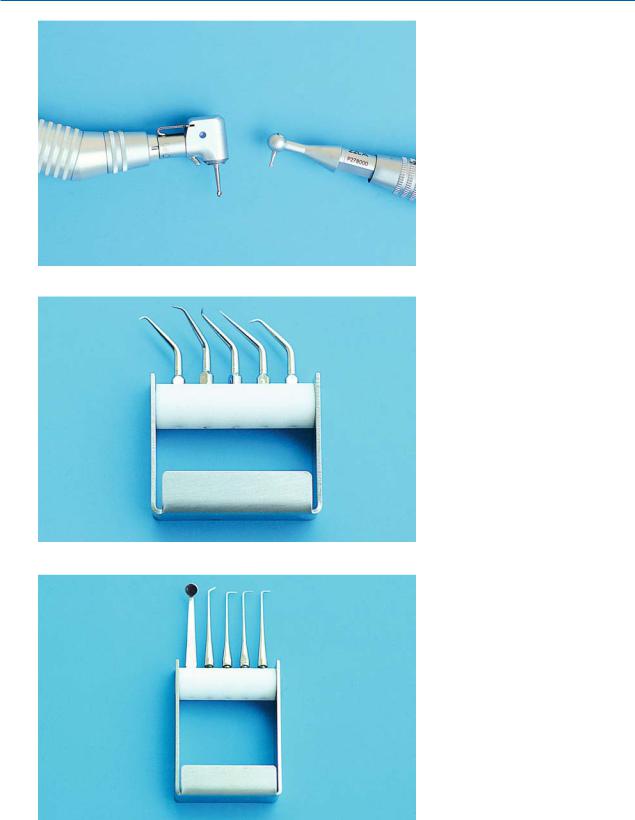
310 F. D. Fragiskos
Fig. 13.1. Microhead handpiece compared to a conventional handpiece. With this handpiece, preparation of the periapical cavity is greatly facilitated in areas with limited access
Fig. 13.2. Special narrow periapical curette tips that may be adapted to an ultrasonic device. They are used for preparation of the periapical cavity in areas with limited access
Fig. 13.3. Apical retrograde micromirror and micro-explorers for determining the dimensions of the created periapical cavity
ΟPeriodontal curette.
ΟPeriapical curette.
ΟAppropriate burs (round, fissure, inverted cone).
ΟMiniaturized amalgam applicator for retrograde fillings (Figs. 13.4, 13.5).
ΟNarrow amalgam condensers (Fig. 13.6).
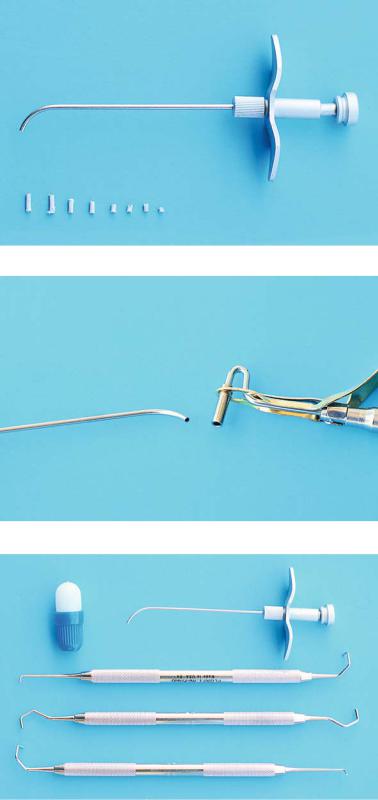
Chapter 13 Apicoectomy |
311 |
Fig. 13.4. Miniaturized amalgam applicator for retrograde fillings, with a knob that controls amalgam increment size
Fig. 13.5. Miniaturized amalgam applicator compared to a standard amalgam carrier
Fig. 13.6. Instruments and materials for retrograde filling. Amalgam capsule (top left). Miniaturized amalgam applicator (top right). Narrow amalgam condensers, with tips appropriately shaped so that they may enter narrow areas easily (bottom)
Ο |
Scissors, needles and no. 3–0 and 4–0 sutures. |
Ο |
Syringe for irrigating surgical field. |
Ο |
Metal endodontic ruler. |
Ο |
Saline solution. |
Ο |
Gauze and cotton rolls/pellets. |
|
|

312 F. D. Fragiskos
13.4
Surgical Technique
The procedure for apicoectomy includes the following steps:
1.Designing of flap.
2.Localization of apex, exposure of the periapical area and removal of pathological tissue.
3.Resection of apex of tooth.
4.Retrograde filling, if deemed necessary.
5.Wound cleansing and suturing.
Designing of Flap. Flap design depends on various factors, which mainly include position of the tooth, presence of a periodontal pocket, presence of a prosthetic restoration, and the extent of the periapical lesion.
There are three types of flaps principally used for apicoectomy: the semilunar, triangular, and trapezoidal. The semilunar flap is indicated for surgical procedures of limited extent and is usually created at the anterior region of the maxilla, which is where most apicoectomies are performed. In order to ensure optimal wound healing, the incision must be made at a distance from the presumed borders of the bony defect, so that the flap is repositioned over healthy bone.
If there is an extensive bony defect, especially towards the alveolar crest, then the triangular or trapezoidal flap is preferred. It must be noted that the pathological lesion, which has perforated the bone and has become attached to the periosteum, must be separated from the flap with a scalpel. In case of a fistula, the fistulous tract must also be excised near the bone, because, if it is excised at the mucosa, then there is risk of even greater perforation, resulting in disturbances of the healing process.
When the apicoectomy is performed at the anterior region (e.g., maxillary lateral incisor) and there is an extensive bony defect near the alveolar crest (Figs. 13.7,
13.8), the surgical procedure is performed using a trapezoidal flap. The incision for creating the flap begins at the mesial aspect of the central incisor and, after continuing around the cervical lines of the teeth, ends at the distal aspect of the canine. With a periosteal elevator, the mucoperiosteum is then carefully reflected upwards (Figs. 13.9, 13.10).
Localization and Exposure of Apex. The next step after creating a flap is localization and exposure of the apex. When the periapical lesion has perforated the buccal bone, localization and exposure of the root tip is easy, after removing the pathological tissues with a
curette. If the buccal bone covering the lesion has not been completely destroyed, but is very thin, then its surface is detected with an explorer or dental curette, whereupon, due to decreased bone density, the underlying bone is easily removed and the apex localized. When the buccal bone remains completely intact, then the root tip may be located with a radiograph. More specifically, after taking a radiograph, the length of the root is determined with a sterilized endodontic file or metal endodontic ruler. The length measured is then transferred to the surgical field, determining the exact position of the root tip. Afterwards, with a round bur and a steady stream of saline solution, the bone covering the root tip is removed peripherally, creating an osseous window until the apex of the tooth is exposed (Fig. 13.11). If the overlying bone is thin and the pathological lesion is large, the osseous window is enlarged with a blunt bur or a rongeur. Enough bone is removed until easy access to the entire lesion is permitted. A curette is then used to remove pathological tissue and every foreign body or filling material, while resection of the root tip follows (Fig. 13.12).
Resection of Apex of Tooth. The apex is resected (2–3 mm of the total root length) with a narrow fissure bur and beveled at a 45° angle to the long axis of the tooth (Fig. 13.13). For the best possible visualization of the root tip (Fig. 13.14), the beveled surface must be facing the dental surgeon. After this procedure, the cavity is inspected and all pathological tissue is meticulously removed by curettage, especially in the area behind the apex of the tooth. If the entire root canal is not completely filled with filling material or if the seal is inadequate, then retrograde filling is deemed necessary.
Retrograde Filling. After beveling of the apex and curettage of periapical tissues, gauze impregnated with adrenaline to minimize bleeding is placed in the bony defect. A microhead handpiece with a narrow round microbur is then used to prepare a cavity approximately 2 mm long, with a diameter slightly larger than that of the root canal (Fig. 13.15). The cavity may be enlarged at its base using an inverted cone-shaped bur to undercut the preparation for better retention of the filling material (Fig. 13.16). During preparation of the cavity, the dentist must pay careful attention to the width of the cavity, which must be as narrow as possible, because there is a risk of weakening the root tip and causing a fracture (which may not even be perceived) during condensing. After drying the bone cavity with gauze or a cotton pellet, sterile gauze is packed inside the bone deficit and around the apex of the
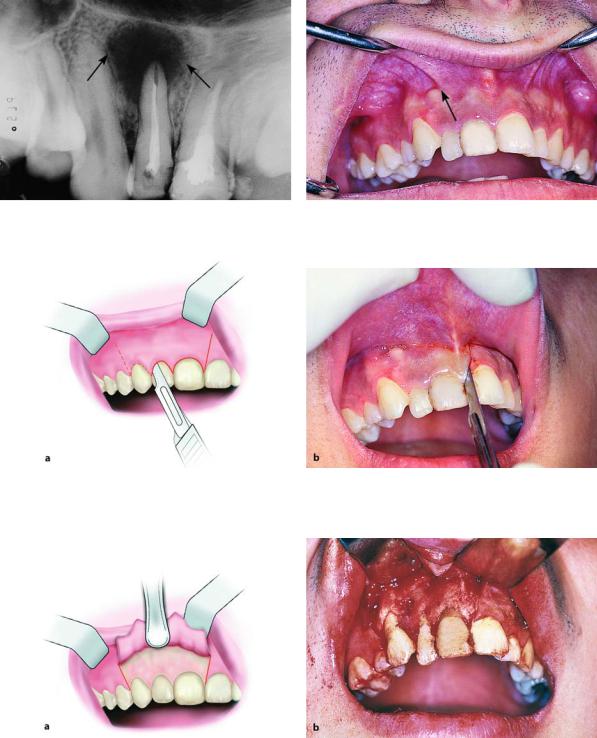
Chapter 13 Apicoectomy |
313 |
Apicoectomy with Trapezoidal Flap
Fig. 13.7. Extensive periapical lesion at maxillary right lateral incisor. Indication for apicoectomy
Fig. 13.8. Clinical photograph of case shown in Fig. 13.7. Arrow points to possible location of lesion
Fig. 13.9 a, b. Surgical procedure for removal of periapical lesion, together with apicoectomy at lateral incisor of maxilla. Incision for creation of trapezoidal flap. a Diagrammatic illustration. b Clinical photograph
Fig. 13.10 a, b. Reflection of mucoperiosteum and exposure of labial alveolar plate after elevation of flap. a Diagrammatic illustration. b Clinical photograph
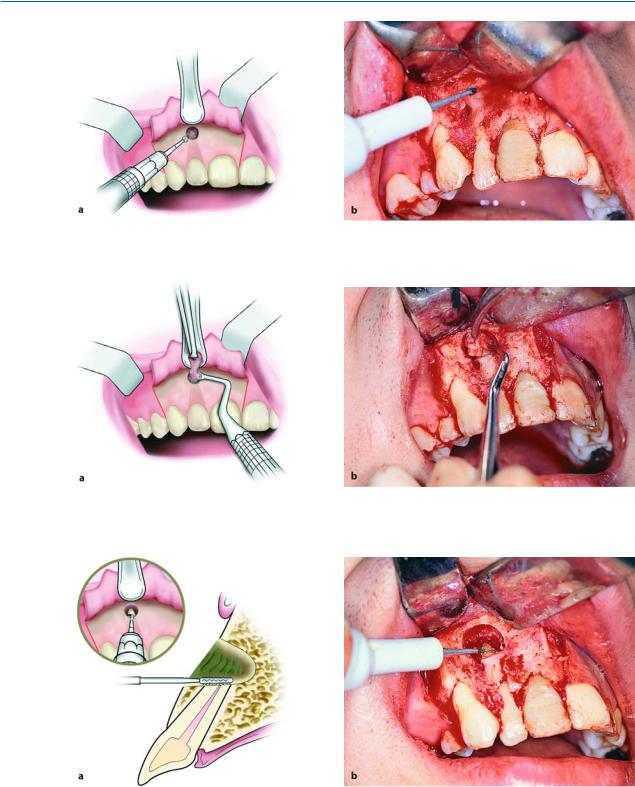
314 F. D. Fragiskos
Fig. 13.11 a, b. Removal of labial bone covering apical third of root. a Diagrammatic illustration. b Clinical photograph
Fig. 13.12 a, b. Removal of periapical lesion with hemostat and curette. a Diagrammatic illustration. b Clinical photograph
Fig. 13.13 a, b. Resection of apex with fissure bur and beveling at a 45° angle. The resection faces the surgeon and is at a distance of 2–3 mm from the root tip
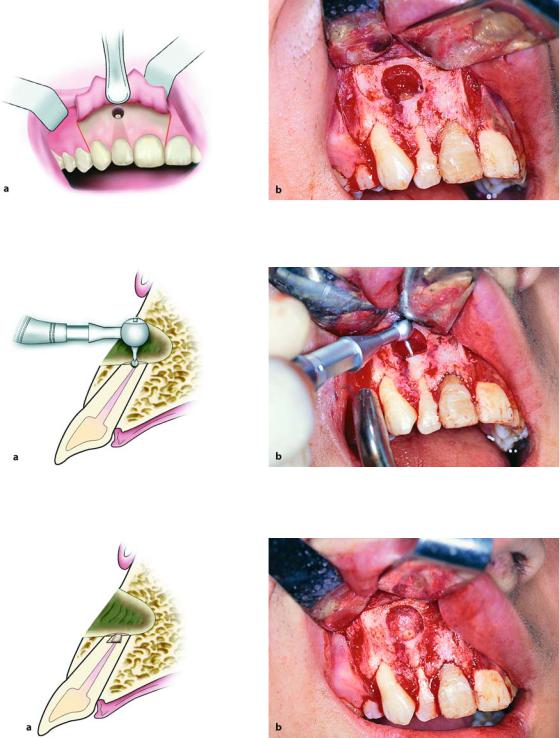
Chapter 13 Apicoectomy |
315 |
Fig. 13.14 a, b. Diagrammatic illustration (a) and clinical photograph (b) showing beveled root of lateral incisor
Fig. 13.15 a, b. Preparation of cavity at root tip of tooth using microhead handpiece. a Diagrammatic illustration. b Clinical photograph
Fig. 13.16 a, b. Cavity created (inverted cone-shaped) where filling material is to be placed. a Diagrammatic illustration. b Clinical photograph
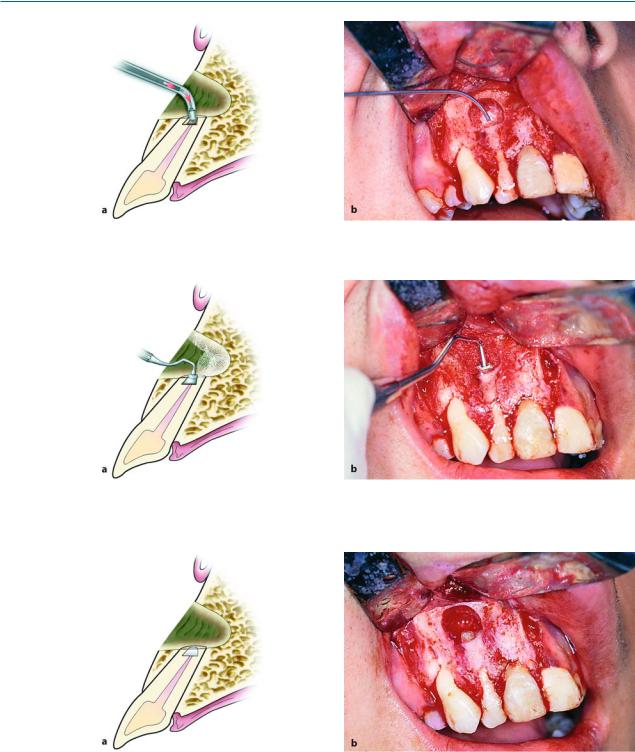
316 F. D. Fragiskos
Fig. 13.17 a, b. Placement of filling material in cavity of apex using miniaturized amalgam applicator. a Diagrammatic illustration. b Clinical photograph
Fig. 13.18 a, b. Condensing of amalgam with narrow amalgam condenser. a Diagrammatic illustration. b Clinical photograph
Fig. 13.19 a, b. Diagrammatic illustration (a) and clinical photograph (b) showing the apex of the tooth with retrograde filling complete
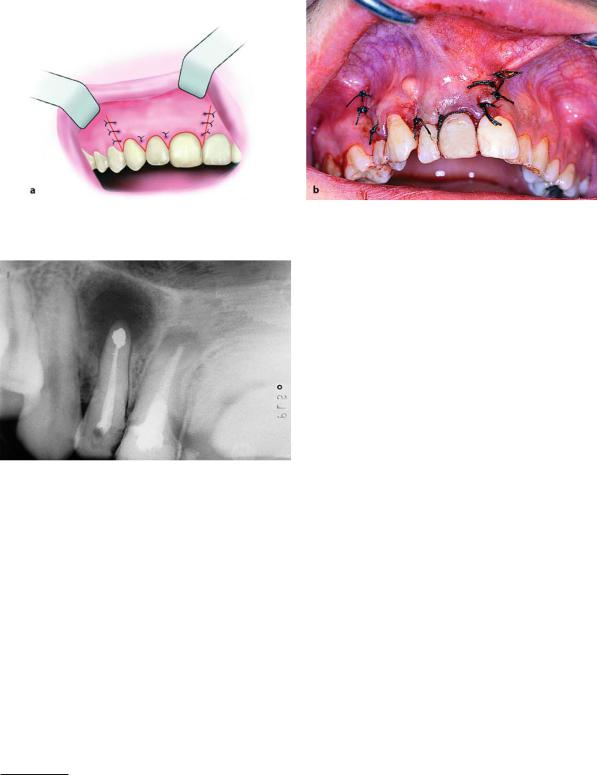
Chapter 13 Apicoectomy |
317 |
Fig. 13.20 a, b. Operation site and placement of sutures. a Diagrammatic illustration. b Clinical photograph
Fig. 13.21. Radiograph taken before suturing of flap, which shows retrograde amalgam filling
tooth, in such a way that only the prepared cavity of the root end is exposed. Splattering of amalgam1) is thus avoided at the periapical region. The amalgam is placed inside the cavity with the miniaturized amalgam applicator and is condensed with the narrow amalgam condenser (Figs. 13.17, 13.18). The excess
amalgam is carefully removed and the filling is smoothed with the usual instruments (Fig. 13.19).
Wound Cleansing and Suturing of Flap. After placement of the amalgam, the gauze is carefully removed from the bony defect and, after copious irrigation with saline solution, a radiographic examination is performed to determine if there is amalgam splattering in the surrounding tissues. The flap is repositioned and interrupted sutures are placed (Figs. 13.20,
13.21). Healing of the periapical area is checked every 6–12 months radiographically, until ossification of the cavity is ascertained. In order to evaluate the result, a preoperative radiograph is necessary, which will be compared to the postoperative radiographs later.
When apicoectomy is performed in the anterior region (e.g., maxillary central incisor) and the size of the lesion is small, and when there are esthetic crowns on the anterior teeth, the semilunar flap is preferred.
The procedure in such a case is similar to that of the previously mentioned surgical procedure employing the trapezoidal flap (Figs. 13.22–13.35).
1)Amalgam is the most commonly used retrograde filling material. Recently, though, IRM and Super-EBA cement have been considered choice materials, with preparation of the cavity being performed in exactly the same way as that for amalgam.
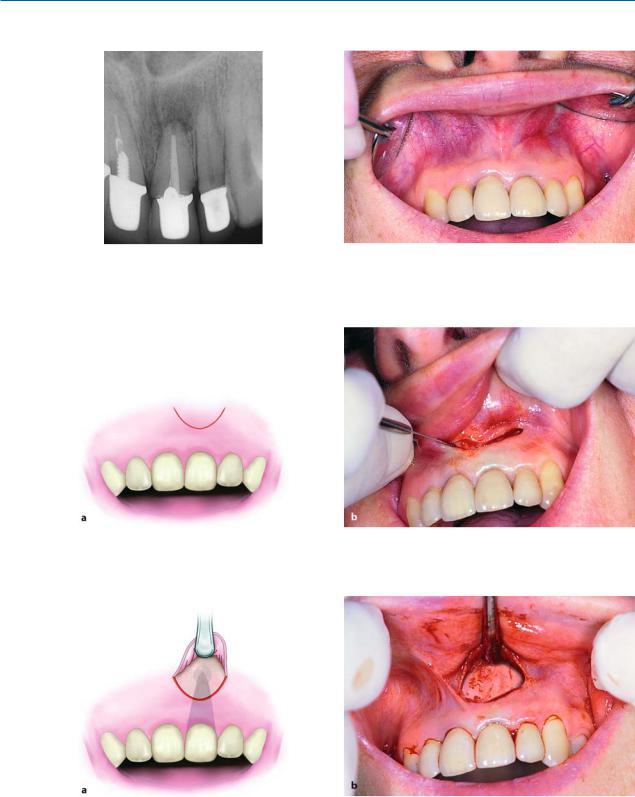
318F. D. Fragiskos
Apicoectomy with Semilunar Flap
Fig. 13.22. Radiograph of maxillary central incisor, show- |
Fig. 13.23. Clinical photograph of the case shown in |
ing periapical lesion and unsatisfactory filling of the root |
Fig. 13.22 |
canal |
|
Fig. 13.24 a, b. Surgical procedure for apicoectomy at maxillary left central incisor. Semilunar incision made for flap. a Diagrammatic illustration. b Clinical photograph
Fig. 13.25 a, b. Reflection of flap and retraction with broad end of periosteal elevator. a Diagrammatic illustration. b Clinical photograph
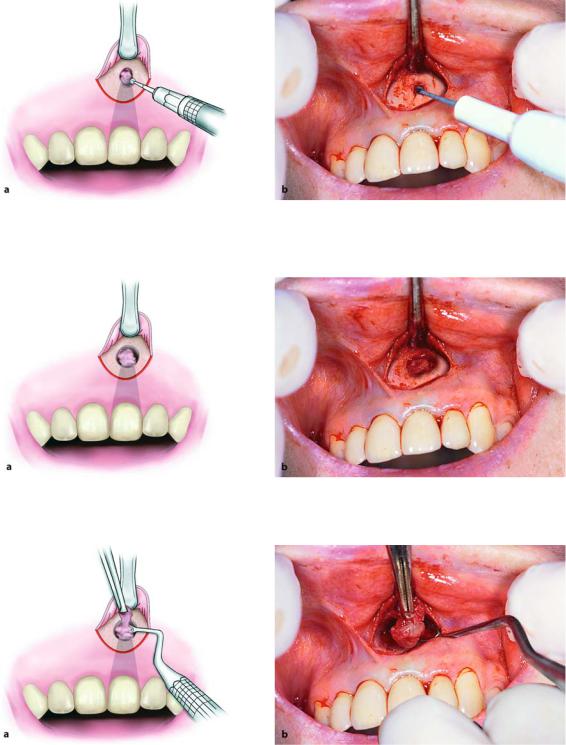
Chapter 13 Apicoectomy |
319 |
Fig. 13.26 a, b. Removal of bone covering apex of tooth. a Diagrammatic illustration. b Clinical photograph
Fig. 13.27 a, b. Exposing periapical lesion and apex of tooth together after removal of respective buccal bone. a Diagrammatic illustration. b Clinical photograph
Fig. 13.28 a, b. Removal of periapical lesion with hemostat and periapical curette. a Diagrammatic illustration. b Clinical photograph
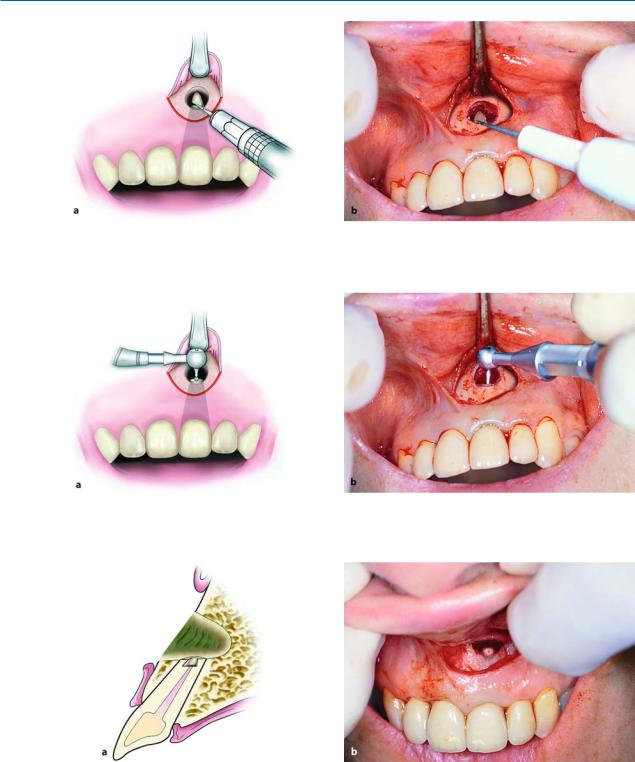
320 F. D. Fragiskos
Fig. 13.29 a, b. Resection of apex of tooth at a 45° angle. a Diagrammatic illustration. b Clinical photograph
Fig. 13.30 a, b. Preparation of cavity at apex with microhead handpiece. a Diagrammatic illustration. b Clinical photograph
Fig. 13.31 a, b. Diagrammatic illustration (a) and clinical photograph (b) showing prepared cavity ready for placement of filling
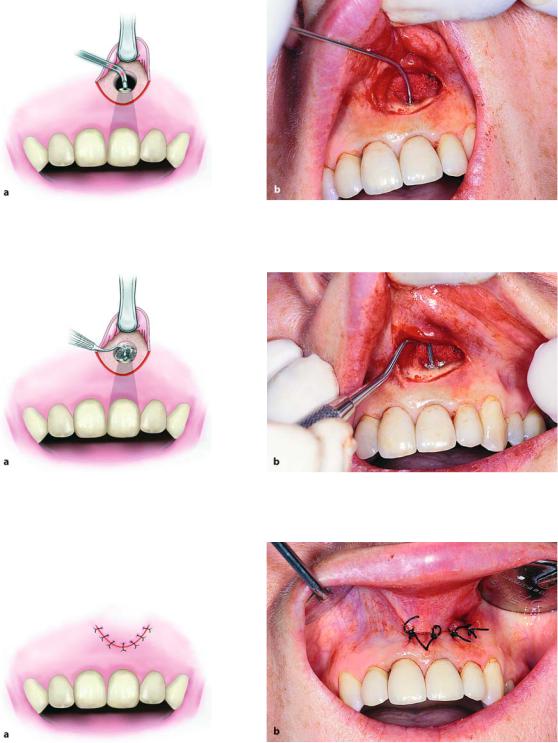
Chapter 13 Apicoectomy |
321 |
Fig. 13.32 a, b. Placement of filling at root tip with miniaturized amalgam applicator. a Diagrammatic illustration. b Clinical photograph
Fig. 13.33 a, b. Condensing amalgam at periapical cavity with narrow amalgam condenser. a Diagrammatic illustration. b Clinical photograph
Fig. 13.34 a, b. Operation site after placement of sutures. a Diagrammatic illustration. b Clinical photograph
